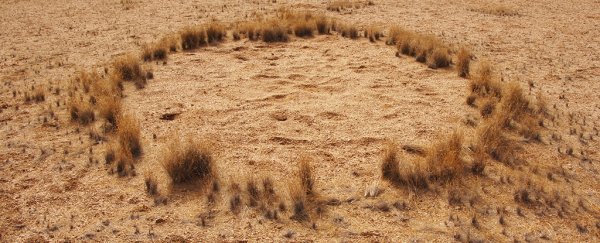Scientists could finally have a clearer picture of what causes mysterious dry patches to appear in some arid grasslands, with new research suggesting that so-called fairy circles show plants positioning themselves to make the most of available water resources.
In other words, it's all to do with the hunt for what will keep them alive. This hypothesis was first put forward in 2014, and now scientists have even more evidence to support the science behind this bizarre phenomenon.
If you're new to the fairy circle saga, these vast, symmetrical patches of dry ground have intrigued scientists for years, as they were first spotted in the Namib desert and then more recently in the Australian outback.
Measuring up to 34.7 metres (114 feet) in size, and often surrounded by rings of vegetation, millions of these circles exist, and researchers have suggested they could have been caused by termites nibbling at plant roots, or by a shortage of water, or both.
The latest research, carried out in the Namib desert by a team from Indiana University-Purdue University Indianapolis, adds support to the water shortage hypothesis.
Researchers took detailed measurements of water infiltration rates, soil moisture, grass biometrics, and sediment grain-size distribution from multiple circles and the spaces between them.
What they found were much faster water infiltration rates inside the circles, helped by coarser soil particle sizes, and grass roots that were much larger on the inside of the circle.
"That means the grass puts its roots on the inner side of the ring, competing for water," says one of the researchers, Lixin Wang.
"When it does rain, water flows to the edge of the circles, where the grass's roots can take the water for their use."
The scientists think the bare patches are acting as reservoirs, percolating more water that the grass around the edges can access. Vegetation then naturally arranges itself in a circular shape around these reservoirs.
That's a smart way to survive when you're in one of the most inhospitable places on Earth. But what about the termites idea?
"The fairy circles selected for our experiments lacked any sign of sand termite activity or disturbance due to foraging animals," write the researchers, though they aren't ruling out termites completely.
As we reported earlier this year, it's possible that the battle for nutrients creates small bare patches of earth, which then get wider and wider until a balance is found again.
At that point, grass and other plants cluster around the bare patches to take advantage of the greater water supply – something termites could also be attracted by.
The team says more research is needed to understand exactly how these regular patterns are formed, but we now have more evidence that water is a key part of whatever's going on here – along with more vital data for scientists to pore over.
The findings have been published in the Journal of Geophysical Research: Biogeosciences.
